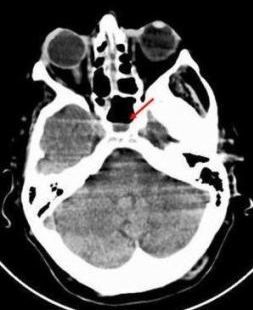A Woman With Delirium From Diabetic Ketoacidosis
Mucormycosis, an angioinvasive yeast infection of the Mucorales order of the class of Zygomycetes, often grows in patients with diabetes mellitus, especially in the presence of diabetic ketoacidosis.

Figure 1
A 67-year-old woman presented to the emergency department (ED) with delirium resulting from diabetic ketoacidosis. She also complained of headache, facial pain, nasal congestion, left eye pain, and blurry vision of 2 weeks’ duration. She noted recent bloody nasal discharge and confusion, which was her reason to come to the ED.
The patient’s past medical history was significant for type 2 diabetes mellitus (DM) with neuropathy, arthritis, multiple urinary tract infections, cataracts, and obesity. She denied smoking and alcohol and drug use. She lives alone with a cat.
Vital signs were temperature, 36.7°C (98°F); pulse, 114 beats/min; respiratory rate, 25 breaths/min; blood pressure, 116/20 mm Hg; oxygen saturation, 98% on room air. She was not oriented to place or time.
Examination revealed signs of inflammation and some exudates in the patient’s left ear canal, dried blood around her nares, and dry mucous membranes.
Lung and heart examination findings were normal.
Laboratory findings were significant: fasting glucose level of 800 mg/dL (normal range, 70 to 100 mg/dL), with an anion gap of 28 mmol/L (normal range, 2 to 16 mmol/L) and hemoglobin A1C (HbA1c) level of 15.9% (normal range, 5% to 6%). The leukocyte count was 32.3/mL (normal range, 4.5 to 10/mL), with 7% bands (normal range, 3% to 5%).
A CT scan of the patient’s sinus (Figure 1) showed ethmoidal sinus congestion with air-fluid levels in the sphenoidal sinuses. Maxillary sinuses and turbinates appeared thickened, and there was left supraorbital soft tissue swelling.
The patient was admitted to the ICU and placed on a diabetic ketoacidosis protocol. By the third day after admission, the diabetic ketoacidosis had resolved; however, the patient continued to complain of sinus tenderness and headache. Otolaryngology debrided her sinuses, and this decreased her pain.

Figure 2
On day 8, the patient was discharged to a nursing facility for general debility and received an outpatient follow-up referral to ENT. During the visit, further sinus debridement showed necrotic areas of the sinuses.
The patient was readmitted and had bilateral maxillary antrostomy, total ethmoidectomy, and sphenoidotomy. Histopathology using Gomori methenamine-silver nitrate stain revealed broad-based, irregular, ribbon-like, nonseptate hyphae with branching, as seen in Figure 2.What’s Your Diagnosis?